IMEHA (International Model Equine Hobbyists Association) was an online photo showing site that existing until 2018. Included on the site were these guidebooks for judging and showing model horses in Performance classes. MEPSA has obtained permission to share the info contained in the guides.
Point Deducts :: Tack :: Rider :: Set-Up Options :: Photo Examples
A timed event, barrel racing is judged strictly on the time and a completed and correct pattern of a cloverleaf around three barrels. A five second penalty is added for each barrel knocked over and disqualification for going off pattern. Size of pattern varies by breed association but average is 30 -35 yards apart in a triangle. Some associations add a penalty for a lost hat. Mistakes to look for: Split reins, unsafe equipment. *NAN guidelines allows that preference given to barrel saddles over other saddles due to speed factoring in over heavy saddles. (I had a AAA AQHA mare that I ran a few barrels with one summer on a dare from friends when she was home from the track. I didn’t own a gymkhana saddle and she flew over those things in my show saddle. We were never defeated. The mare’s name was Rondelisle by Parker Bar.)
(a) The course must be measured exactly according to diagram and cannot exceed these dimensions. However, if the course is too large for the available space, the pattern should be reduced five yards at a time until the pattern fits the arena. Adequate space must remain between barrels and any obstacle. The distance from barrel number three to the finish line need not be reduced five yards (4.6 meters) at a time if there is sufficient room for the horse to stop. When measuring the area for the barrel course, allow ample room for horses to complete their turns and stop at the finish. It is recommended there be at least 45 feet (13.5 meters) from the starting line to the end of the arena, at least 18 feet (5.4 meters) from barrels 1 and 2 to the fence and 36 feet (10.8 meters) from barrel 3 to the end of the arena.
(b) Brightly colored 55 gallon (200 liters) steel drums with both ends in must be used. There shall be no rubber or plastic barrels or barrel pads used.
(c) Starting line markers or electric timers, when possible, shall be placed against the arena fence. An electric timer or at least two watches shall be used, with the time indicated by the electric timer or average time of the watches used by official timers to be the official time.
(d) Timing shall begin as soon as the horse’s nose reaches the starting line and will be stopped when the horse’s nose passes over the finish line.
(e) The contestant is allowed a running start. At a signal from the starter, the contestant will run to barrel number 1, pass to the left of it, and complete an approximately 360 degree turn around it; then go to barrel number 2, pass to the right of it, and complete a slightly more than 360 degree turn around it; then go to barrel number 3, pass to the right of it, and do another approximately 360 degree turn around it; then sprint to the finish line, passing between barrel number 1 and 2. This barrel course may also be run to the left. For example, the contestants will start to barrel number 2, turning to left around this barrel, then to barrel number 1, turning to the right, then to barrel number 3, turning again to the right, followed by the final sprint to the finish line.
(f) Knocking over a barrel carries a five-second penalty. Failure to follow the course shall cause disqualification. A contestant may touch the barrel with his or her hands in barrel racing.
(g) A five second penalty will be assessed if the hat or helmet is not on the exhibitor’s person for the entire time the exhibitor is in the arena in barrel racing.
(h) The judge must disqualify any contestant for excessive use of a whip, rope, crop, bat or reins anywhere on the horse.
(i) If a tie occurs where points are involved, placing will be worked off if all tied exhibitors agree to participate in a run-off, if not, a coin toss will be used to separate the ties. The horse declared the winner in the runoff must rerun the pattern within two seconds of its original time or the runoff must be held again. Penalty time will not apply to the two-second rule but will apply to the final runoff time.
Extra Credit Should Be Given If:
(1) Roping Reins and not romal or split reins.
(2) Entry Number is shown on saddle blanket or on rider’s back.
(3) A comment line that says where the horse is in the pattern.
(4) Color coordinated rider and equipment.
(5) Model cuts in extremely close to barrel.
(6) Model exhibits flexion, tork or supple body bends around barrels.
Points Should be Deducted If…
(1) Rider uses spurs forward of the cinch.
(2) Loss of hat
Required Tack:
A western stock saddle without tapaderos. The saddle can have either squared or rounded skirts. Can be gaming, working or show saddle. Breastplates are optional. A saddle pad resting under all pressure points is recommended but not required equipment. A western style bridle (browband, one ear, two ear, with or without throatlatch) with a curb bit including a curb strap or curb chain. Standard snaffle bit and bosal hackamores are permitted on horses 4 and under (5 and under for Arabians and Appaloosas). Roping rein are typically seen. Split reins can be used and are typically knotted together. Tie-downs and leg protection are optional.
Prohibited Tack:
Tapaderos are prohibited.
Rider:
Attire is jeans, trousers or pants over western boots, long sleeved shirts, (vest, tie and jacket are also permitted) belt through loop, and western hat. Chaps are optional.
Set-Up Options:
Arena Fencing Required (Indoor or Outdoor Arena)
Types of Fencing Allowed:
- Painted or Natural
- Post and Rail
- Post and Plank
- Chain Link
- Solid Plyboard
- Plyboard with Top Rail
- Post with Drape Rope
- Stock Tube Pipe Rail
- Interior Arena Wall
Footing Required:
- Dirt
- Sand
- No grass base
- No rock base
Backboard or Natural Setting (Indoor or Outdoor)
Examples of Barrel Racing:
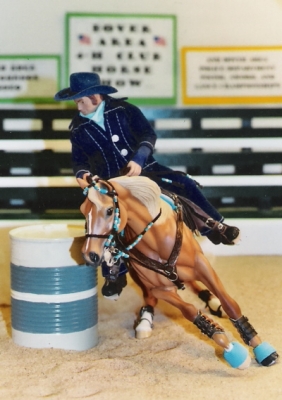
Photo Credit:
Western Barrel Racing
El Paso shown as a Chestnut QH gelding, mold is Ltd. Ed. Whiplash resin by Williams & Nandell. Props, some tack pieces, doll, photo by Kim Jacobs.
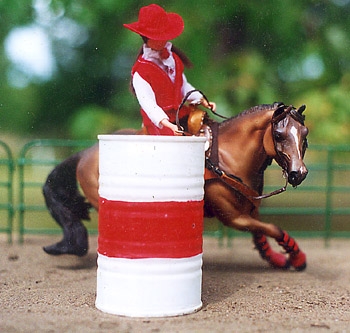
Photo Credit:
Western Barrel Racing
DJS Disco Mama shown a Buckskin QH Mare. Mold is Williams/Nandell Power Steering AR. Shown by Sue Sudekum.
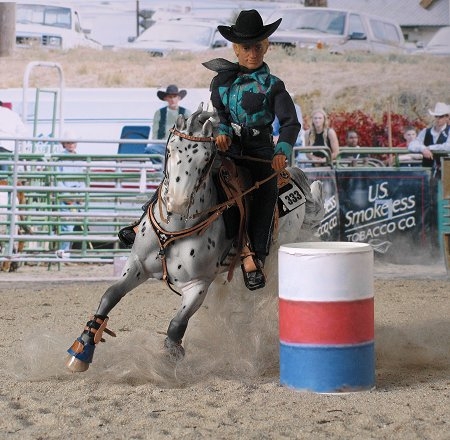
Photo Credit:
Western Barrel Racing
Leopard Rock shown as a Black Semi-leopard Appaloosa Sport Horse (Hanovarian x Appaloosa) mare. Mold is a CM Breyer Show Jumping Warm blood – Ideal. Comment line reads: Entrant rounds the final barrel in the Barrel Racing Pattern before dashing for the finish line.
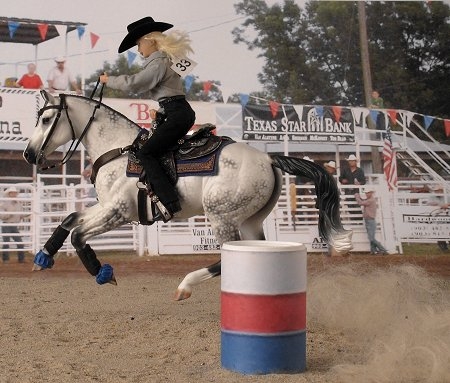
Photo Credit:
Western Barrel Racing
Apparition shown as a dappled gray Hanoverian mare. Mold is a CM Breyer Show jumper by Donahue. Shown by Andrea Robbins with comment line: Having raced around the 2nd barrel, horse and rider gallop toward the 3rd barrel in the pattern.
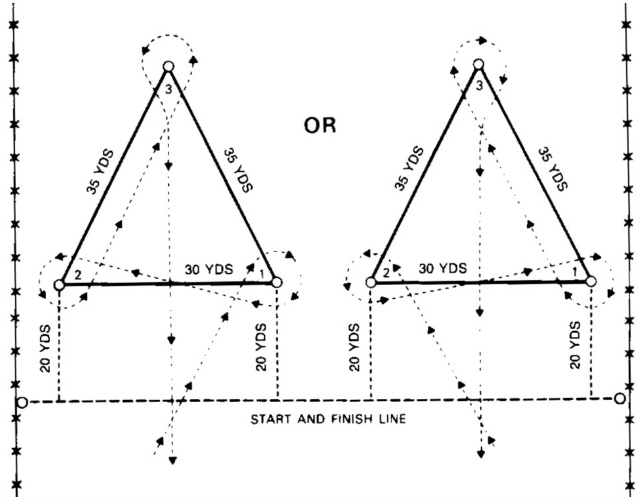
Barrel Racing Pattern
